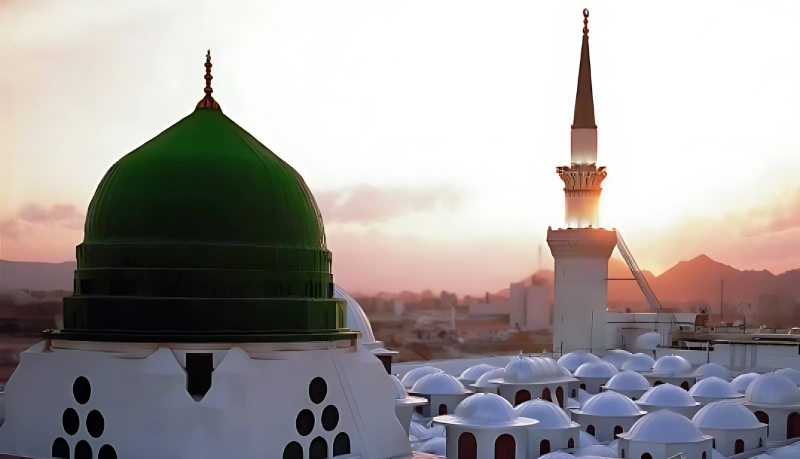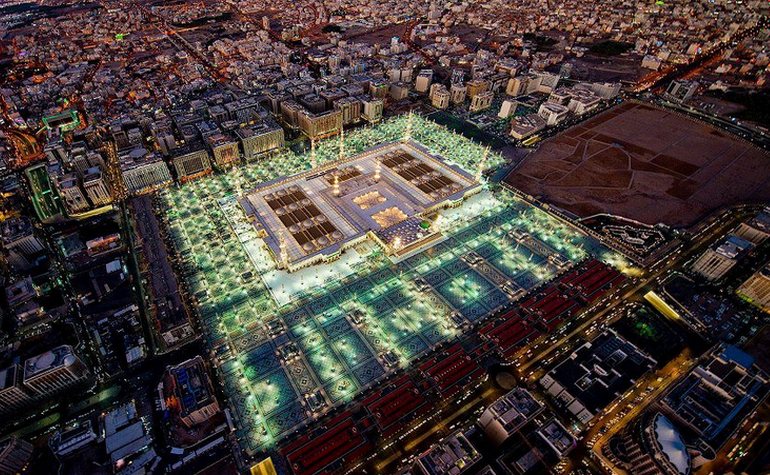
The Prophet (ﷺ) said, “Madina is a sanctuary from that place to that. Its trees should not be cut and no heresy should be innovated nor any sin should be committed in it, and whoever innovates in it heresy or commits sins ( bad deeds), then he will incur the curse of Allah, the angels, and all the people. ”
Reference
Sahih Bukhari
Vol. 3, Book 30, Hadith 91.
The Prophet (ﷺ) said, “I have made Medina a sanctuary between its two (Harrat) mountains.” The Prophet (ﷺ) went to the tribe of Bani Haritha and said (to them), “I see that you have gone out of the sanctuary,” but looking around, he added, “No, you are inside the sanctuary.”
Reference
Sahih Bukhari
Vol. 3, Book 30, Hadith 93.
The holy city achieved the endorsement after a WHO team visited Madina. They found that Madina met all the global standards necessary to be a healthy city. Madinah is supposed to be the first city with a population of more than 2 million to be documented underneath the organization’s healthy cities program. A sum of 22 government, community, charity, and volunteer agencies helped prepare for the WHO authorization and endorsement.
The city incorporated a program that included a strategic venture with Taibah University to record government requirements on an electronic proposal for the WHO evaluation.
WHO also suggested that the university may offer guidance to other National City agencies concerned in taking part in the healthy cities program?
Definition of healthy cities
According to WHO “A healthy city is one that is continually creating and improving those physical and social environments and expanding those community resources which enable people to mutually support each other in performing all the functions of life and developing to their maximum potential.”
The background to healthy cities
“Health is created and lived by people within the settings of their everyday life; where they learn, work, play, and love.”
The Ottawa Charter, 1986
This declaration is in the spirit of the Healthy city background and approach, which has its extraction in the WHO Health for All plan and, more particularly, the Ottawa Charter for Health endorsement. The objective is to make the most of disease avoidance via a “whole system” approach, which puts together multi-disciplinary action across risk factors. The key principles of all Healthy Settings include community contribution, corporation, empowerment, and fairness.
The Healthy Cities agenda is the best-known example of a successful Healthy Settings approach. Started by WHO in 1986, Healthy Cities have extended quickly across Europe and other parts of the world.
What is a Healthy City?
A Healthy City aims to establish the goals and objectives:
- To create a healthy sustainable environment
- To achieve an excellent quality of life and existence
- To provide basic cleanliness and sanitation needs
- To supply right of entry to the healthcare system
The WHO healthy city endorsement depends not on current health infrastructure and system, to a certain extent upon a pledge to improving a city’s vicinity and a readiness to forge the necessary connections in political, economic, and social arenas three aspects of sustainability.

Settlement according to Principles of Quran and Sunnah
Millions of Muslims visit the Prophet’s Mosque in Madinah every year, but very few know that Madinah Munawwarah, the City of Light, is not only the first settlement in Islam but also a shining example of urban planning based on principles outlined in the Quran and Sunnah. There are many principles found in the Prophet’s planning of Madinah that should be considered when building future Muslim dwellings.
The Prophet, peace be upon him, started by building a mosque in the center of his growing community. Then he distributed the quarters, properties, and houses to the muhajireen, other immigrants, original tribes, the Ansar, and other individuals. The urban characteristics of this settlement became the planning standard that was later followed in most traditional Islamic cities.
The entire rationale of Islamic environmental ethics is based on the Qur’anic concept of Khilafah. Man is the trustee who has the responsibility of looking after the vast panorama of God’s creation. Man can use the trust for his benefit but has no absolute right to anything. Man is accountable for the misuse of his trust and is liable to pay a price both in this world and the akhirah (Hereafter).
Vision for a Sustainable Madinah
The urbanization of Median started way back in 1973.The latest modernization plan started in 200.This plans projected for Madinah are aligned with the visions and goals of the New Urban Agenda and are based on the three dimensions of sustainability. As such, the overall vision that emerges from the combination of the three strategic recommendations aims at structurally changing Madinah’s urban for to achieve the following three aspects of sustainability
- Environmental sustainability:
- Social sustainability:
- Economic sustainability:
Environmental sustainability
Maintaining safe and comfortable living environments through lower emissions and opting for ecological restoration and complex socio-ecological infrastructure, that can devise basic services innovatively.
Social sustainability
Securing social equity in the distribution of wealth and social services to all corners of the society.
Economic sustainability
Keeping a stable economic growth while restructuring the productive system to save resources and energy.
This three-dimensional vision for Madina is implemented by the development and growth strategy and a structural Plan. The Development and Growth Strategy establishes the vision statement and the planning principles that serve as the foundation for the comprehensive plan.
To enact this vision, which aims to trigger an incremental but radical urban transformation process, it is necessary to translate the four conceptual recommendations into a logical and scaffolded system of actions that sets clear priorities and builds on endogenous potential and competitive advantages.
Overall, Madinah has the opportunity to set itself on the right track towards a more sustainable urban development model, as some of the presented issues also embed opportunities for their solutions. Implementing all of this requires a strong political will, coupled with a pragmatic approach to the city’s socio-economic and spatial restructuring, capitalizing on the strengths and opportunities to enhance and rebalance the ecological, social, and economic dimensions, while preserving Madinah’s unique socio-spatial and historical identity.



